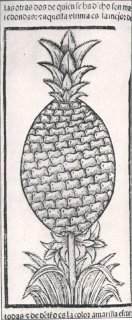 Today, March 31st …
Today, March 31st …A young woman called Annabella Boswell recorded in her journal the details of everyday life on her uncle’s magnificent homestead near Port Macquarie, New South Wales in the first half of the nineteenth century.
The well-to-do household had a well-staffed kitchen, but Annabella occasionally tried her own hand at cooking. On this day in 1848 she recorded her preserving efforts:
“Made two pineapples into jelly – when peeled they wieghed 3 ½ pounds each. The gardener weighed several lately, the heaviest weighing 4lb 1 oz. They are very fine and plentiful but none of us like them. I made the jelly as we do apples, but it never jellied properley, and is more like honey both in colour and substance”
Here we have a small mystery partly due to two countries being divided by a confusing culinary language. Was she making ‘jam’(thick conserve to spread on bread), or ‘jelly’(a cold dessert ‘set’ with hartshorn, calves foot, or gelatine)? Surely not the latter, for ‘everyone’ knows that pineapple contains the enzyme bromelain, which prevents gelatine from setting. Cooking destroys the enzyme, which is why using canned pineapple does not cause the problem, and why there should be no problem when ‘jam’ is being made.
American readers are at an advantage here: ‘jelly’ being to them what English and Australians think of as ‘jam’, they will assume that Annabella’s problem would have been due to insufficient sugar or insufficient boiling. It is English-English which causes confusion, because ‘jelly’ can also mean a semi-transparent ‘jam’ made from fruit juice or strained fruit. Which did Annabella make?
Eliza Acton explains one method of making Apple Jelly in her “Modern Cookery” (1845)
Apple Calf’s Feet Jelly.
Pour a quart of prepared apple juice on a pound of fresh apples pared and cored, and simmer them until they are well-broken; strain the juice, and let it stand until cold; them measure, an put a pint and a half of it into a stewpan with a quart of calf’s feet stock, nine ounces of sugar broken small or roughly pounded, the juice of two fine lemons, and the thin rinds of one and a half, with the whites and shells of eight eggs. Let it boil gently for ten minutes, then strain it through a flannel-bag, and when cool put into moulds. It will be very clear, and firm, and of a pleasant flavour.
[The image of the pineapple is courtesy of http://www.tinypineapple.com/ . It appeared in the "Historia general y natural de las Indias, Islas y Tierra-Firme del Mar Oceano" (1535) by Father Gonzalode Oviedo y Valdes, who went to the Americas in 1513.]
On Monday: A surgeon’s biscuits.
2 comments:
Great.anoother Brisbane person with a blog.............also....thanks for visiting my food forum. How did you find it?
Hello Little Mick; I was specifically looking for Brisbane food blogs. We need to catch up with Sydney and Melbourne!
Post a Comment